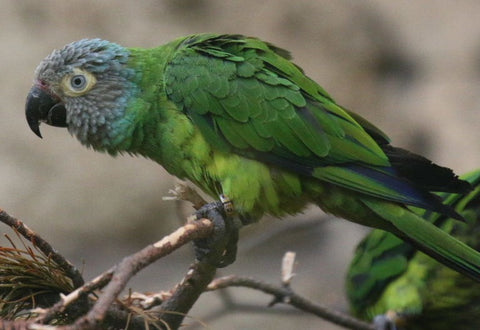The Dusky Conure: A Comprehensive Guide to the Dusky-Headed Conure

The dusky conure, also known as the dusky-headed conure, is a charming and intelligent bird that captivates pet owners and bird enthusiasts alike. With its playful demeanor and striking appearance, this parrot species has become increasingly popular in aviculture. In this article, we will explore the dusky conure’s characteristics, habitat, behavior, care requirements, and more.
1. Overview of the Dusky Conure
1.1 Taxonomy and Classification
The dusky conure (Aratinga weddellii) is part of the family Psittacidae, which includes many other parrot species. It is a member of the Aratinga genus, characterized by their playful nature and vibrant colors. The dusky-headed conure is often distinguished by its unique coloration and distinct personality traits.
1.2 Physical Characteristics
Dusky conures are medium-sized birds, typically measuring about 10 to 12 inches in length. They have a predominantly green body, with darker green feathers on their wings and back. The most striking feature is their dusky-colored head, which can range from gray to brown, giving them their common name. Their beaks are strong and curved, designed for cracking seeds and nuts, while their tails are long and pointed, enhancing their agility in flight.
2. Natural Habitat
2.1 Geographic Range
Dusky-headed conures are native to the forests and woodlands of South America, particularly in regions of Bolivia, Brazil, and Paraguay. They thrive in subtropical and tropical climates, where they can find abundant food sources and nesting sites.
2.2 Habitat Preferences
In the wild, dusky conures are often found in flocks, which provides safety in numbers. They prefer areas with plenty of trees, where they can forage for fruits, seeds, and nuts. These birds are highly social and typically establish communal roosting sites, which can be a delightful sight for bird watchers.
3. Behavior and Social Structure
3.1 Social Behavior
dusky headed conure are known for their friendly and social nature. They thrive on interaction, whether with other birds or humans. Their playful behavior includes climbing, swinging, and vocalizing, which can provide hours of entertainment for their owners. They communicate through a variety of sounds, including whistles and chirps .
.
3.2 Playfulness and Intelligence
These birds are highly intelligent and require mental stimulation to prevent boredom. Engaging them with toys, puzzles, and interactive play can help keep their minds sharp. Training dusky conures to perform tricks or respond to commands can strengthen the bond between the bird and its owner.
4. Diet and Nutrition
4.1 Natural Diet
In the wild, the diet of the dusky-headed conure consists primarily of fruits, seeds, nuts, and berries. Their natural foraging behavior allows them to obtain a balanced diet rich in nutrients.
4.2 Nutritional Needs in Captivity
When kept as pets, dusky conures require a well-balanced diet to thrive. A high-quality pelleted diet, supplemented with fresh fruits and vegetables, is ideal. Owners should avoid feeding them avocado, chocolate, and caffeine, as these foods can be toxic to birds.
4.3 Treats and Supplements
In addition to their regular diet, offering occasional treats like nuts or seeds can be a great way to bond with a dusky conure. However, treats should be given in moderation to maintain a healthy weight and prevent dietary imbalances.
5. Care Requirements
5.1 Housing
Providing an appropriate living environment is essential for a dusky conure’s well-being. A spacious cage with horizontal bars allows for climbing and exploration. The cage should be equipped with perches, toys, and feeding dishes to encourage natural behaviors.
5.2 Social Interaction
Dusky conures are social birds and thrive on interaction. It is recommended to spend time daily with your bird, engaging in play and training. If possible, consider having more than one conure to provide companionship.
5.3 Grooming
Regular grooming is important for the health of your dusky-headed conure. This includes trimming their nails, providing baths to maintain feather condition, and ensuring their beak is healthy. Regular check-ups with an avian veterinarian can help monitor your bird’s overall health.
6. Training and Behavior Management
6.1 Positive Reinforcement
Training dusky conures can be a rewarding experience. Utilizing positive reinforcement techniques, such as treats and praise, can encourage desired behaviors. Start with simple commands and gradually increase the complexity of the tasks as your bird becomes more comfortable.
6.2 Addressing Behavioral Issues
Like all pets, dusky conures may exhibit unwanted behaviors, such as biting or excessive squawking. Identifying the cause of these behaviors—such as fear, boredom, or lack of socialization—is key to addressing them. Consistency in training and providing ample mental stimulation can help mitigate behavioral problems.
7. Health Considerations
7.1 Common Health Issues
Dusky conures are generally healthy birds, but they can be prone to certain health issues, such as feather plucking, obesity, and respiratory infections. Regular vet check-ups and a healthy diet are crucial for early detection and prevention.
7.2 Signs of Illness
Owners should be vigilant for signs of illness, including changes in appetite, lethargy, or abnormal droppings. If any concerning symptoms arise, seeking prompt veterinary care is essential to ensure your dusky-headed conure’s health and well-being.
8. Breeding and Reproduction
8.1 Breeding Behavior
In the wild, dusky-headed conures typically nest in tree cavities, where they lay 3 to 5 eggs. The breeding season usually occurs during the warmer months when food is abundant.
8.2 Nesting Requirements
For those interested in breeding dusky conures, providing a suitable nesting box is vital. The box should be spacious enough for the female to lay her eggs comfortably. It’s essential to ensure that the breeding pair is healthy and well-cared for to increase the chances of successful breeding.
9. The Dusky Conure as a Pet
9.1 Benefits of Owning a Dusky Conure
Dusky conures make excellent pets due to their playful nature, intelligence, and affectionate behavior. They can form strong bonds with their owners and provide companionship for years to come.
9.2 Considerations Before Adopting
Potential owners should consider their lifestyle and commitment level before adopting a dusky-headed conure. These birds require daily interaction, mental stimulation, and a commitment to their care and well-being.
10. Conclusion
The dusky conure, or dusky-headed conure, is a delightful and engaging pet that can bring joy and companionship to any household. With their playful personalities and striking appearance, these birds make for wonderful companions. By understanding their needs and providing proper care, owners can ensure that their dusky conure leads a happy and healthy life.
References
- [1] Psittacine Bird Society. “Dusky Conure Care.”
- [2] The Bird Channel. “Understanding Parrot Behavior.”
- [3] Avian Medicine Journal. “Nutritional Needs of Conures.”


